The 15 Most Hydrating Foods

Cavan Images / Getty Images
Medically reviewed by Jamie Johnson, RDN
Proper hydration helps regulate body temperature, lubricates and cushions joints, protects the spinal cord and other sensitive tissues in the body, and supports waste elimination. Adequate fluid also helps prevent dehydration, a condition that can increase kidney stone risk and lead to unclear thinking, mood changes, overheating, and constipation.
A 2023 National Institutes of Health study also concluded that well-hydrated adults may remain healthier, develop fewer chronic conditions, such as heart and lung disease, and live longer than those who don’t get sufficient fluids. Researchers say that staying well hydrated may slow down the aging process, prevent or delay chronic diseases, and extend longevity.
Drinking enough water is important, but your total daily fluid intake doesn’t come from beverages alone. Various foods provide water too, and some are quite hydrating. Here are 15 foods that help meet your daily fluid needs, how much water each provides, and the bonus health benefits they offer.
1. Cucumber
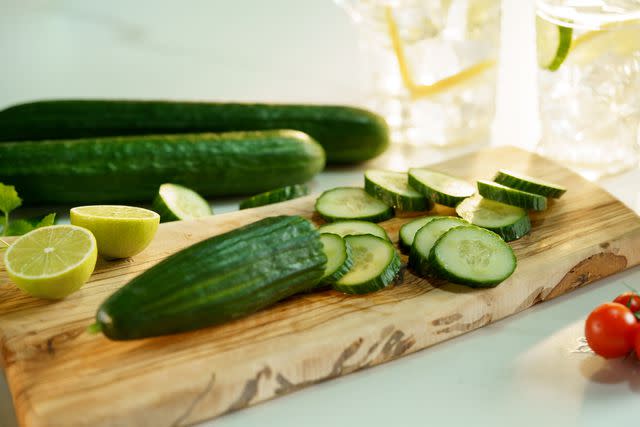
Getty Images
95% water, 10 ounces (oz) of water per cucumber
The most hydrating food on the list, one whole cucumber (about 8.25 inches in length) provides more than a full cup of water and provides just 45 calories.
This sized cucumber with the skin is also high in vitamin K, providing more than 40% of the Daily Value (DV). This key nutrient supports bone health and is needed to allow your blood to clot properly, which means to stop bleeding if you accidentally cut yourself.
Enjoy cucumber by itself, add it to salads, sandwiches, and sushi, or slice and top with healthy spreads, like or vegan pesto or herbed tahini. Cucumbers can also be blended into smoothies or pureed as a base for a thirst-quenching mocktail.
2. Zucchini
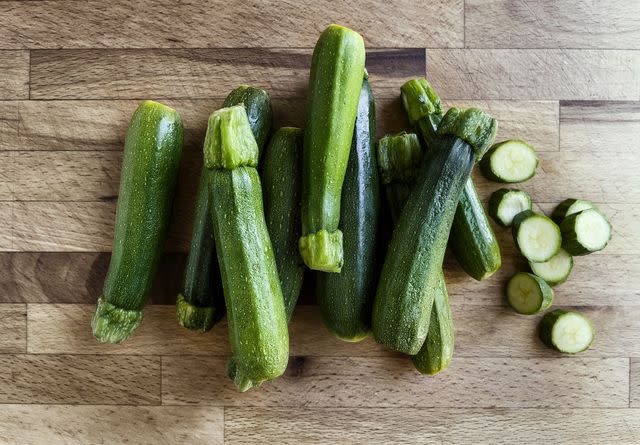
Claudia Totir / Getty Images
95% water, 4.2 oz of water per cup, chopped
Zucchini is low in calories with just 21 calories per cup of chopped zucchini. In addition to its water content, it provides antioxidants that protect against DNA damage that can lead to diseases like cancer. A one-cup portion supplies about a quarter of the daily vitamin C target along with smaller amounts of potassium, magnesium, and B vitamins.
Blend zucchini into smoothies or shred and fold into oatmeal or overnight oats. Toss spiralized zucchini noodles or ribbons with extra virgin olive oil, fresh vegetables, herbs, and white beans. Add zucchini to salads, soups, chili, stir-fries, pasta dishes, or even desserts, like carrot cake, brownies, and apple cobbler.
3. Celery

Anastasiia Krivenok / Getty Images
95% water, 3.9 oz of water per three medium stalks of celery
Crisp, refreshing celery contains several powerful antioxidants known to fend off free radicals, compounds formed naturally in your body from metabolism, and exposure to other environmental pollutants. At high levels, free radicals trigger what’s known as oxidative stress, which can damage cell DNA and increase your risk of conditions such as heart disease and diabetes.
Use celery to scoop up healthy dips, like guacamole, hummus, or olive tapenade. Or for a sweet snack, fill the hollowed-out part of celery stalks with nut or seed butter topped with dried tart cherries, chopped dark chocolate, or shredded coconut.
4. Tomatoes

Katrin Ray Shumakov / Getty Images
94% water, 4 oz of water per medium tomato
In addition to great water content, tomatoes are low in calories (22 per this size) and provide several antioxidants in addition to potassium, iron, folate, and vitamin C. Tomato antioxidants are linked to anti-inflammation and protection against cancer, heart disease, diabetes, and neurodegenerative diseases, including Alzheimer’s and Parkinson’s. They also support fertility, immune, gut, and skin health. The latter is through their anti-inflammatory effects and ability to prevent damage caused by UV radiation. The potassium and vitamin A and vitamin C found in tomatoes have also been linked to fewer skin wrinkles. Finally, tomatoes reduce exercise-induced cell damage.
At breakfast add tomatoes to a scramble made with eggs, tofu, or chickpeas, or add it to avocado toast or a breakfast salad. Add fresh tomatoes to salads, chilled pasta salads, and sandwiches, or serve them sliced as a side dish garnished with fresh basil and balsamic vinegar. Pop grape or cherry tomatoes as a snack, pair them with hummus, or serve on toothpicks alternated with Mediterranean olives.
5. Cabbage
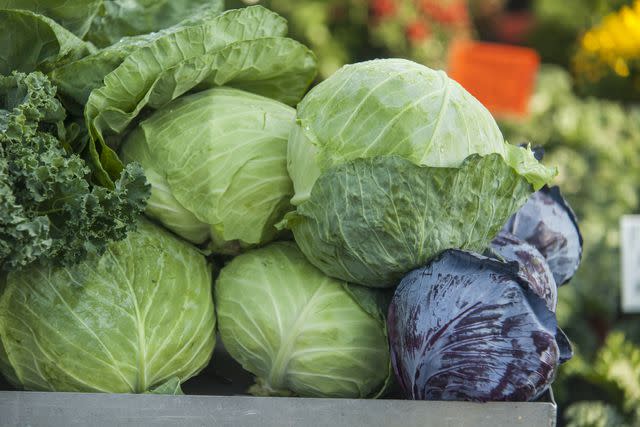
Richard T. Nowitz / Getty Images
92% water, 2.2 oz of water per cup of shredded cabbage
Cabbage is a member of the cruciferous vegetable family, along with broccoli, cauliflower, Brussels sprouts, kale, and others. Numerous studies have found that daily consumption of cruciferous vegetables helps prevent cancer, particularly colorectal cancer. The effect is likely due to natural compounds in cabbage which combat viruses and bacteria, protect cells against DNA damage, inactivate cancer-causing substances, and prevent cancer cells from growing and spreading.
To retain the most water, enjoy cabbage raw, in slaws and salads, or as a topping for tacos, or avocado toast.
6. Mushrooms
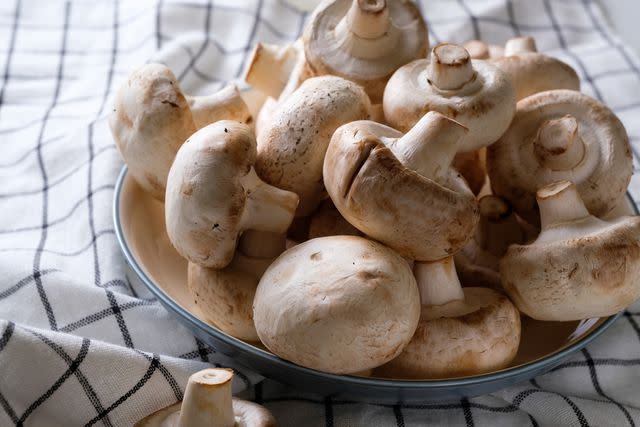
Aleksandr Zubkov / Getty Images
92% water, 2.2 oz of water per cup of sliced mushrooms
Mushrooms are very low in calories, with just 15 calories per cup of sliced mushrooms. They’re also chock full of healthy bioactive compounds. These include a few grams of plant protein, vitamins, minerals, and antioxidants. Mushrooms also contain natural immune, heart, and gut-supporting compounds with anti-inflammatory, anti-diabetic, anti-obesity, anti-aging, and anti-cancer effects.
To preserve the water in these gems, enjoy mushrooms raw, slathered with hummus, marinated in balsamic vinaigrette as a chilled side dish, or sliced and added to salads. You can also lightly sauté them over low heat to prevent excess water loss.
7. Strawberries

George / Getty Images
91% water, 5.3 oz of water per cup of sliced strawberries
Strawberries are rich in anti-inflammatory antioxidants, as well as fiber and vitamin C. One cup of sliced strawberries provides more than 3 grams (g) of fiber, 10% of the DV, and more than an entire day’s worth of vitamin C.
Polyphenol antioxidants found in strawberries are linked to protection against cancer, heart diseases, type 2 diabetes, obesity, and neurodegenerative diseases, like Alzheimer’s.
Strawberries work well in both sweet and savory dishes. Blend them into smoothies, add to hot or cold cereal, serve them over pancakes, or pair them with dark chocolate hummus. Add strawberries to garden salads, avocado salsa, grilled tofu, or chilled grain dishes, like wild rice, quinoa, or farro.
8. Watermelon
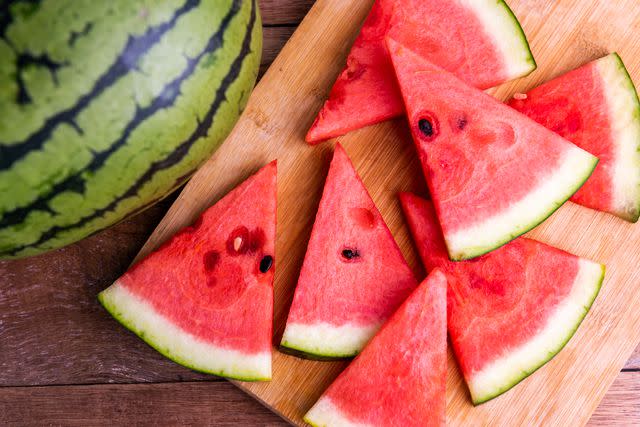
HUIZENG HU / Getty Images
91% water, 4.9 oz of water per cup of diced watermelon
Watermelon is lower in sugar relative to its natural sweetness. It has a little more than 9 grams of sugar per cup of diced watermelon. A recent research review concluded that watermelon, which is rich in antioxidants, provides benefits for heart and gut health, diabetes regulation, and weight management, in addition to cancer protection.
Enjoy watermelon by itself or blend seedless chunks of watermelon with ice, fresh lime juice, and mint to make a hydrating slushy drink. Add watermelon to salads and salsa or garnish fresh cubes or balls with pumpkin seeds, minced avocado, nuts, or chopped dark chocolate.
9. Cantaloupe
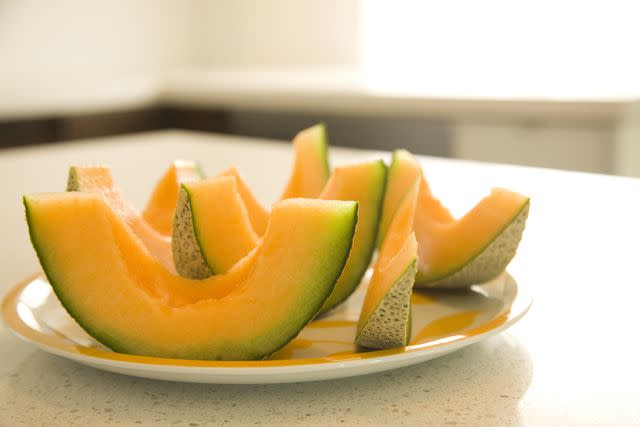
RCWW, Inc. / Getty Images
90% water, 5 oz of water per cup of cubed cantaloupe
It’s pretty obvious that juicy cantaloupe is water-rich, but it’s also bursting with other nutrients, including antioxidants. Cantaloupe’s orange color is due to beta-carotene, a pigment that also serves as a source of vitamin A. A one-cup serving of cantaloupe contains more than a day’s worth of the recommended daily vitamin A intake for adult women and men.
Vitamin A supports healthy immune function and vision and helps the heart, lungs, and other organs work properly. Enjoy cantaloupe by itself or add it to fruit or garden salads, slaw, or salsa. Or puree cantaloupe to create a refreshing drink or chilled soup. A halved melon with the seeds removed also makes a perfect bowl for yogurt, or a chilled tofu or white bean salad.
10. Jicama
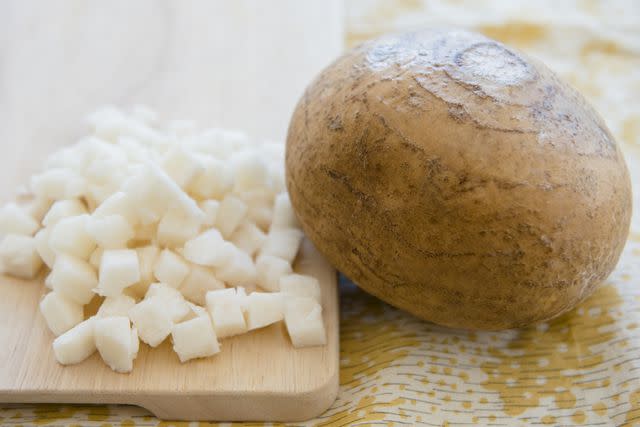
Jamie Grill/Tetra Images / Getty Images
90% water, 3.8 oz of water per cup of sliced jicama
One cup of jicama provides just 45 calories and 10 grams of carbohydrates with an impressive 6 grams of fiber, more than 20% of the DV.
One recent research review referred to jicama as an underutilized plant with immune-supporting abilities and antioxidant, anticancer, anti-diabetes, anti-osteoporosis, antiviral, and anti-aging effects.
Use sliced raw jicama as you would celery or carrot sticks served with healthy dips. Toss shaved jicama with mustard vinaigrette for a nutritious chilled side dish. Or use wider, round jicama slices in place of tortillas and fill with sauteed or grilled veggies, lentils or black beans, and sliced avocado.
11. Kale

HUIZENG HU / Getty Images
90% water, 1.3 oz of water per two cups of raw kale
While kale is 90% water in its composition, it provides less total water per portion. But, like cabbage, it’s a member of the cruciferous vegetable family, and it’s quite healthy.
A 2-cup serving of kale provides less than 20 calories, along with a wide variety of nutrients, including antioxidants, vitamins A, C, and K, folate, potassium, calcium, magnesium, dietary fiber, and prebiotics, which support the growth of beneficial probiotic gut microbes.
Research shows that eating patterns high in fiber and green leafy vegetables are tied to improved blood sugar control and a lower risk of type 2 diabetes.
Blend kale into smoothies, use it as a salad base, incorporate it into pesto or hummus, and add it to everything from soups (which will capture any water loss from heating) to sandwiches and stir-fries.
12. Silken Tofu
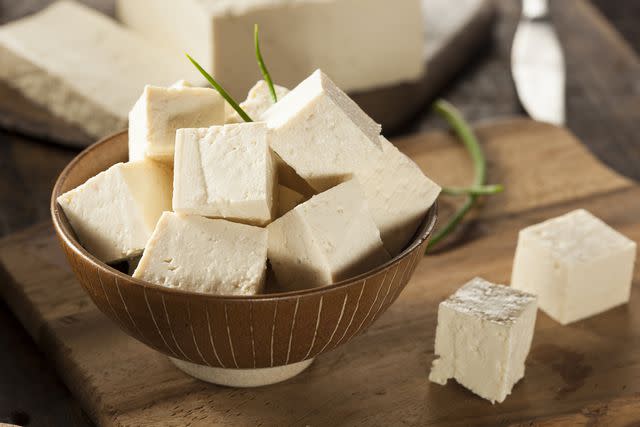
Dragos Rusu / Getty Images
90% water, 2.9 oz of water per 1/5 of a package of tofu
Tofu is another hydrating protein option, particularly silken tofu, which contains more fluid than firm or extra firm varieties. In addition to plant protein, tofu provides antioxidants called isoflavones. A study published in 2020 found that over 20 years, people who had the highest intake of isoflavones had the lowest risk of heart disease.
Yet not all soy products offered equal protection. Soy milk wasn’t associated with a reduced risk of heart disease, but men and women who ate tofu at least once a week had a lower risk than those who ate it less than once a month. For females, the protective effect of tofu was primarily seen in younger women and postmenopausal women who had not used hormone therapy.
Silken tofu can be blended into smoothies or used as a base for blended soups and creamy sauces, dressings, and dips. It’s also a staple in vegan desserts, like cheesecake, pumpkin, sweet potato, or chocolate pie, and puddings.
13. Grapefruit
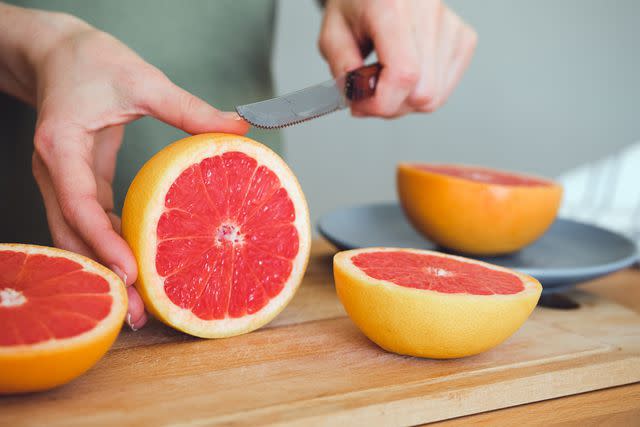
Aleksandr Zubkov / Getty Images
88% water, 3.8 oz of water per half a grapefruit
Half of a grapefruit provides about 50 calories and nearly 40 milligrams (mg) of vitamin C, more than 40% of the DV for this nutrient that supports your immune system, skin, and bone health.
One research review also found that among women, grapefruit consumption was associated with lower body weight, smaller waist measurements, lower body mass indices (BMIs), higher “good” HDL cholesterol, and lower levels of triglycerides (blood fats) and C-reactive protein (CRP, a marker of inflammation).
Slice a grapefruit in half, sprinkle with chopped nuts or diced avocado, and scoop out the triangles. Or peel, slice, and add grapefruit sections to a yogurt parfait, fruit or garden salad, slaw, or stir fry. For a healthy treat, dip grapefruit slices in melted dark chocolate.
14. Pineapple
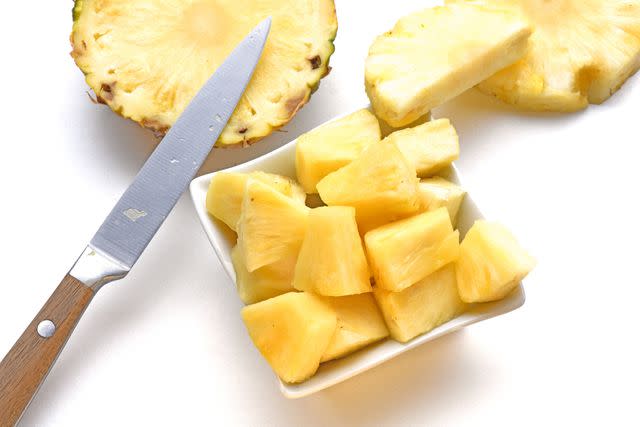
Minh Hoang Cong / Getty Images
86% water, 5 oz of water per cup of pineapple chunks
Pineapple—the third most popular fruit behind bananas and citrus fruits—supports digestive health and provides anti-inflammatory antioxidants.
Vitamin C is one of pineapple’s standout nutrients, with nearly 80 mg per cup, more than 85% of the DV. This tropical fruit also supplies energy-supporting B vitamins, as well as smaller amounts of magnesium and potassium.
Blend pineapple into smoothies, add it to fruit or garden salads, slaws, salsa, and stir fries or use it as a topping for chia seed pudding.
15. Black Beans
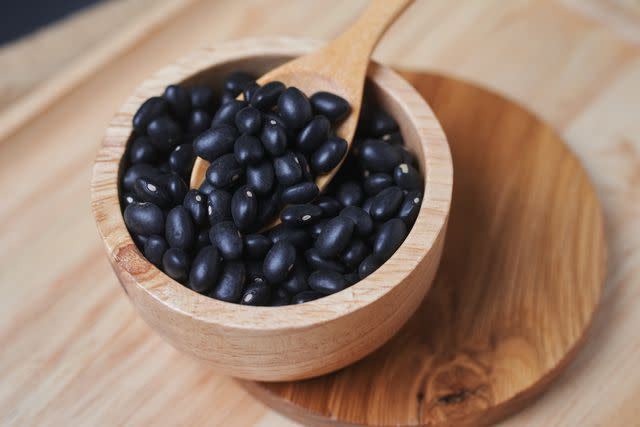
Krit of Studio OMG / Getty Images
66% water, 4 oz of water per cup of cooked black beans
You may not think of black beans as a water-rich food, but they absorb water when cooked, which makes them a hydrating protein option.
Beans have also been shown to reduce inflammation and support heart health, weight management, blood sugar regulation, and gut health. They’re also rich in antioxidants, fiber, plant protein, and key minerals, including potassium, magnesium, iron, zinc, and calcium.
Use beans in place of meat in salads, tacos, soups, stews, or stir-fries or in dips, served with water-rich raw veggies.
How Much Water Do You Need?
According to the National Academy of Medicine guidelines, total daily fluid needs are 3.7 liters per day for men (over 15 cups of 8 ounces) and 2.7 liters for women (over 11 cups of 8 ounces). This amount is sufficient for most adults, according to a 2023 study that assessed hydration status based on these recommendations.
On average, roughly 20% of daily fluid intake comes from food. This leaves about 96 ounces per day for men and 70 for women, although a higher intake of water-rich foods may supply a greater percentage of your daily fluid needs.
Your body loses water throughout the day through breathing, sweating, and urinating. Your fluid needs increase when more water is lost from your body. This occurs when you sweat (due to exercise or being in a hot climate), or if you experience vomiting or diarrhea.
As a general rule of thumb, people who exercise should:
Drink about 16 ounces (2 cups) of water two hours before a workout.
Continue to sip water during exercise. Aim for about one-half to one cup of fluid every 15-20 minutes. Switch to a sports drink rather than plain water after the first hour to replace both fluid and electrolytes.
Drink water even when you no longer feel thirsty.
Drink 16-24 ounces (3 cups) of fluid for every pound of water you lose while exercising, within six hours of finishing a workout.
It’s important to note that while it’s difficult to do, it is possible to drink too much water. Doing so can lead to a condition called hyponatremia, in which the amount of sodium in the blood becomes too low.
The Centers for Disease Control and Prevention (CDC) advises to never consume more than 48 ounces of fluid within one hour to prevent overloading your system.
Other Tips for Staying Hydrated
Being strategic about your fluid intake can help you consistently meet your needs. Consider these tips:
Whip up a smoothie for breakfast or incorporate water rich foods in other ways. Add shredded zucchini to oatmeal, top avocado toast with cucumber, kale, and tomatoes, and enjoy a side of fresh fruit.
Keep a water bottle with you to sip from throughout the day.
Make garden salads and soups lunch staples.
Snack on water rich fresh fruit or hummus served with raw veggies.
Plan to include more raw produce dishes at dinner, like cabbage slaw, tomato cucumber salad, gazpacho, or cantaloupe soup.
Add lemon, fresh mint, or bits of in season fruit to water to add color and flavor, which may help you drink more.
Use an app that prompts you to stop and drink water or set alarms as reminders.
Limit caffeine to 400-500 mg per day as intakes above this may contribute to dehydration.
A Quick Review
Proper hydration is essential for many functions in the body and is linked to reduced disease risk and increased longevity. While water should be the primary beverage, foods can provide 20% or more of your daily fluid needs. The water rich foods here also offer bonus nutrients and health benefits. Being intentional about consuming fluid, from both foods and drinks, can help support your overall physical and mental well-being.
For more Health.com news, make sure to sign up for our newsletter!
Read the original article on Health.com.

